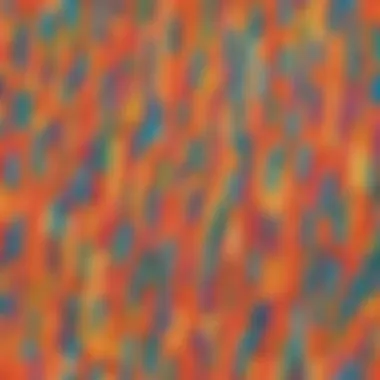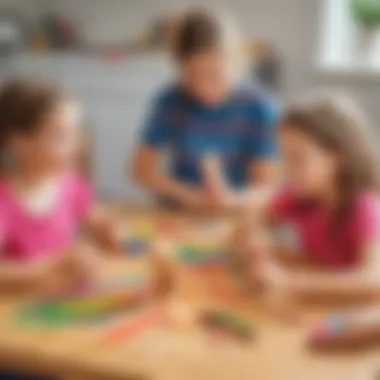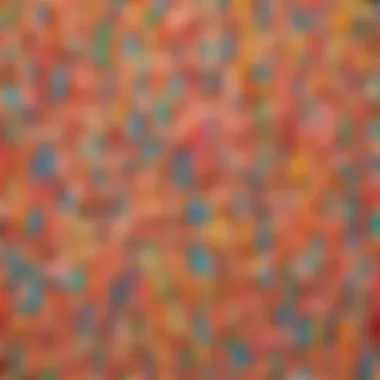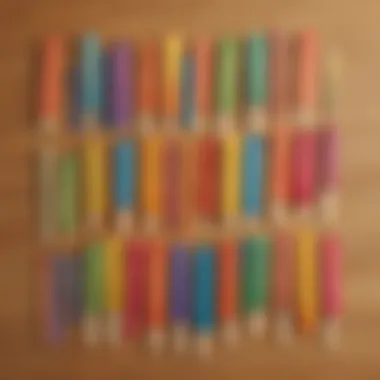Creative Uses of Rainbow Popsicle Sticks for Kids


Intro
Rainbow popsicle sticks are more than just vibrant crafting materials; they are gateways to learning, imagination, and creativity. The colorful nature of these sticks captures the attention of young minds, making them perfect for a myriad of activities that spark curiosity. As parents, educators, or caregivers, engaging children in creative projects can have lasting educational benefits. From honing fine motor skills to enhancing problem-solving abilities, the versatility of rainbow popsicle sticks is truly remarkable.
"Creative activities promote cognitive development and emotional well-being in children."
This article will explore fun activities, educational games, seasonal crafts, and parenting tips to effectively navigate the world of rainbow popsicle sticks. With each section, our aim is to provide practical and thoughtful guidance that enriches children's experiences while fostering creativity and collaboration.
Prelude to Rainbow Popsicle Sticks
In today's environment, crafting materials play a significant role in early education. Rainbow popsicle sticks are one of the most versatile and engaging resources available. They are not just colorful but also practical in various creative activities. The purpose of this section is to delve into the significance and advantages of these sticks in crafting. By understanding their essence, readers can appreciate the multifaceted uses of rainbow popsicle sticks.
Definition and Characteristics
Rainbow popsicle sticks, also known as craft sticks, are wooden sticks often used in arts and crafts projects. They typically come in packs of multiple colors, creating a vibrant palette for children to explore their creativity. These sticks are lightweight, making them easy for young hands to manipulate. Generally measuring about 4.5 inches in length and 0.38 inches in width, their dimensions are convenient for various applications. The smooth surface allows for easy handling and painting.
What sets rainbow popsicle sticks apart is their visual appeal. Children are often attracted to bright colors. Thus, they can inspire artistic expression and imaginative play. Moreover, the sticks are strong enough to support small structures but not so rigid that they cannot be cut or manipulated. Their inherent characteristics make them suitable for both simple and complex projects.
Materials and Sourcing
Materials used in the production of rainbow popsicle sticks are primarily wood. Most commonly, they are made from birch or poplar, which are durable types of timber that allow for robust crafting while maintaining an appealing finish. When sourcing these materials, it is essential to seek non-toxic options. Many manufacturers now offer eco-friendly variants made from sustainable resources.
To procure rainbow popsicle sticks, parents and educators can easily find them at craft stores like Michaels or online platforms such as Amazon. Bulk purchasing can make crafting activities more cost-effective, allowing for multiple projects over time. Checking local stores can also yield unique varieties, which can add an interesting twist to typical crafting sessions.
The Educational Value of Crafting
Crafting with rainbow popsicle sticks offers significant educational benefits that extend beyond simple amusement. Understanding how these activities contribute to a child's development is crucial for parents and educators alike. Involving children in such hands-on tasks helps enhance their overall learning experience. This section will detail various educational values associated with crafting, focusing on skill development and creativity.
Fine Motor Skill Development
Engaging children in crafts that use rainbow popsicle sticks can result in fine motor skill advancements. Fine motor skills involve the small muscles in hands and fingers. When children grasp, manipulate, and assemble popsicle sticks, they enhance their dexterity. This activity requires precise movements to glue, position, or paint, which strengthens hand-eye coordination.
Research indicates that early exposure to such activities prepares children for writing and other intricate tasks in later stages of their education.
- Grasping: Children learn to grip the sticks with varying firmness based on the task.
- Scissors Skills: Cutting the sticks to specific lengths can help practice scissor skills.
- Assembly Techniques: Stacking or gluing popsicle sticks together teaches spatial awareness.
Enhancing Creativity and Imagination
Crafting with rainbow popsicle sticks serves as an excellent outlet for enhancing creativity and imagination. The color and versatility of the sticks allow children to express their visions without boundaries. They can create anything from simple structures to intricate designs. This freedom boosts their confidence in their artistic choices.
The process of imagining and creating also advances cognitive skills. Children begin to understand concepts like symmetry and balance through the designs they experiment with.
- Open-Ended Projects: Using popsicle sticks allows for open-ended exploration, allowing kids to pursue their own ideas.
- Inventiveness: The very nature of crafting encourages kids to think outside the box, pushing their boundaries of what is possible.
Fundamental Math and Spatial Skills
Incorporating rainbow popsicle sticks into creative projects naturally introduces fundamental math and spatial skills. Children can explore basic geometry by constructing shapes or understanding angles with the sticks. This hands-on experience can foster a deeper grasp of mathematical concepts.
Some critical areas where math comes into play include:


- Counting and Sorting: Children can count the number of sticks used or sort them by color or size.
- Shapes and Patterns: Building different designs helps illustrate basic geometric principles.
- Measurement: Kids may learn to measure the lengths of sticks for specific projects, allowing practical applications of math.
Crafting with popsicle sticks is not just play; it is a conduit for essential educational growth.
Creative Projects Using Rainbow Popsicle Sticks
Rainbow popsicle sticks are versatile tools that can spark a variety of creative projects. Through these activities, children can learn important skills while expressing their artistic side. The colorful nature of these sticks not only appeals visually but also encourages engagement in various crafting tasks. The projects can cater to different age groups, making them suitable for both individual and group activities.
Exploring this topic unveils the potential of rainbow popsicle sticks, setting the stage for fun and educational experiences.
Basic Structures and Models
Simple Shapes and Forms
Creating simple shapes and forms with rainbow popsicle sticks is an excellent starting point for young crafters. This activity allows children to grasp basic geometry concepts such as angles and symmetry. By working with these sticks, they can manipulate them to form visual representations of figures, which enhances their spatial awareness.
A key characteristic of simple shapes is their ease of assembly. This feature makes it a beneficial choice for younger children, as they can achieve quick results. The tangible aspect of building shapes reinforces learning and stimulates curiosity.
However, one disadvantage is that without guidance, children might quickly become bored with basic shapes. It is crucial for parents and educators to introduce variations, such as combining shapes or creating more intricate patterns.
Building Technological Models
Using rainbow popsicle sticks to construct models based on technological concepts can be surprisingly effective. This approach fosters a hands-on learning experience that engages children in engineering and problem-solving skills. As they create structures like bridges or towers, they encounter challenges that require creative solutions.
A primary virtue of building technological models is the opportunity it provides for collaborative projects. Working in groups can help develop teamwork and communication skills among children. It makes this method a popular choice in educational settings.
On the downside, children may sometimes struggle to follow more complex designs. Clear instructions or templates should be available to keep them on track and minimize frustration.
Artistic Endeavors
Mosaic Designs
Mosaic designs offer a fantastic way for children to explore color and pattern creation using popsicle sticks. This art form encourages creativity and helps with visual discrimination. Children can arrange sticks into larger patterns, enhancing their fine motor skills and attention to detail.
One key characteristic of mosaic designs is their flexibility in size and complexity. This makes it a beneficial option for varying skill levels. Whether a child is making a small project or a large mural, the possibilities are extensive.
Yet, the main challenge may lie in the time investment required for intricate compositions. Providing time limits or breaking the project into smaller sections can help. This structure ensures children remain focused and make progress.
Colorful Frames
Creating colorful frames using rainbow popsicle sticks can be an enjoyable and practical activity. These frames can hold pictures or artwork, giving a personal touch to displays. The process of frame-making allows fine-tuning of artistic skills, enabling children to explore design principles.
The appeal of colorful frames lies in their functionality. Children can make gifts for family or showcase their achievements. This aspect can add an element of pride and ownership to the craft.
However, the challenge may come from the need for accuracy in measurements and alignments. Guidance on achieving straight lines can help mitigate this issue, ensuring a polished final product.
Functional Creations
Coasters


Creating coasters from rainbow popsicle sticks is a practical way to combine crafting with usability. This project supports creativity while providing children a chance to make something functional. By designing personalized coasters, kids can experience the satisfaction of crafting an item that can be used in everyday life.
A primary characteristic of coasters is their easy assembly process. Simple designs allow for quick creation, making this a beneficial project for short attention spans. Children can also showcase their artistic expression through their choices of colors and patterns.
However, durability is a concern with coasters made from popsicle sticks. Parents should consider sealing the coasters with a clear finish to increase longevity. This additional step enhances the usability of the coasters.
Bookmarks
Rainbow popsicle sticks can also be transformed into bookmarks, making them a useful and creative project. In a world of digital books, children can embrace this analog approach while expressing how they enjoy reading. The individuality of each bookmark can encourage children to take pride in their reading habits.
The main characteristic of bookmarks is their simplicity in design. This makes them a popular choice, as children can complete them in a relatively short time. They can even personalize their bookmarks with drawings or stickers.
But, one potential disadvantage is that bookmarks might be overlooked as a significant creative endeavor. Encouraging children to think about the importance of reading can help attach more value to their creation, making the experience enriching.
Each project idea discussed provides an opportunity for children to explore creativity while learning valuable skills. Whether they are building structures, creating art, or making functional items, rainbow popsicle sticks can play a significant role in inspiring the next generation of creators.
Safety Considerations for Crafting with Children
Incorporating creative activities for children using rainbow popsicle sticks can be incredibly rewarding. However, safety is paramount. Crafting can often involve small components and potentially hazardous materials. Therefore, understanding safety considerations is essential. Ensuring that children engage in these activities safely allows for a fun and enriching experience without unnecessary risks.
Age Appropriateness
When planning crafting activities, it is vital to consider the age of the children involved. Younger children, particularly those under three years old, may have difficulty with small items and may be prone to choking hazards. For instance, using standard-sized popsicle sticks might be suitable for older children, but the miniature versions could pose risks to toddlers.
It is beneficial to choose projects that align with the children's developmental stages. Select activities that not only match their abilities but also keep them engaged. For younger age groups, more straightforward tasks such as gluing sticks together to create structures or shapes can be more appealing and safer. Older children might enjoy more complex projects that involve cutting or painting, where stronger supervision is needed.
Using Non-toxic Materials
Crafting is much more enjoyable when the materials used are safe for children. It is crucial to select products that are specifically formulated as non-toxic. This includes glue, paint, and markers. Many brands such as Elmer's and Crayola offer non-toxic options that are readily available.
Using non-toxic materials protects children from harmful chemicals that could lead to allergic reactions or other health concerns. Always look for labeling that explicitly states the product is non-toxic and, if possible, opt for those that meet safety standards like ASTM or EN71. This not only ensures safety but also promotes responsible crafting habits among kids as they learn to value health-conscious choices.
Supervision Guidelines
While children can enjoy many crafting activities independently, supervision is essential to ensure their safety. Parents and educators should be mindful of the materials being used and the specific tasks children engage in. For instance, if scissors or sharp tools are involved, adult supervision must be present at all times. Even simple tasks like applying glue can lead to messes that require guidance.
Implementing effective supervision means setting clear boundaries and being actively involved in the crafting process. Here are some tips for effective supervision:
- Designate a crafting area: Make sure children know where they can safely create.
- Be present: Observe the children during the crafting to prevent accidents.
- Set rules: Keep discussions ongoing about how to use different materials safely.
"Supervision is not just monitoring; it's an essential part of the educational experience during crafting. It helps children understand safety in a practical setting."
With awareness about age appropriateness, using non-toxic materials, and effectively supervising crafting times, the experience of creating with rainbow popsicle sticks can be both safe and enjoyable for everyone involved.
Incorporating Rainbow Popsicle Sticks into Educational Settings
Incorporating rainbow popsicle sticks into educational settings is an effective method to engage students in learning through hands-on activities. These vibrant crafting materials can foster creativity and enhance various skills such as critical thinking, collaboration, and problem-solving. Using popsicle sticks in class allows educators to create an interactive environment where children can express ideas while learning essential concepts.
Classroom Activities


Classroom activities using rainbow popsicle sticks can vary from simple to complex, catering to different age groups and curricular goals. Some activity ideas include:
- Building 3D Shapes: Children can create different geometric shapes using popsicle sticks. This activity helps reinforce their understanding of shapes, angles, and measurements.
- Science Projects: Students can use popsicle sticks to design simple structures, like bridges or towers, applying elements of physics and engineering principles in a fun way.
- Storytelling: Kids can create puppets or scenery for stories they've written by utilizing the sticks. This encourages creative expression and literacy development.
- Group Challenges: Teachers can set collaborative tasks for students to work in teams, such as building the tallest structure or designing a bridge that can hold weight. This helps develop teamwork and communication skills.
Engaging kids with hands-on learning not only makes education enjoyable but also reinforces critical skills that they will use throughout life.
Integrating into Curriculum Themes
Integrating rainbow popsicle sticks into existing curriculum themes can greatly enhance lessons. Here are some examples:
- Mathematics: Utilize popsicle sticks for visual demonstrations of addition, subtraction, and even fractions, making abstract concepts more tangible.
- History Projects: Create historical structures or artifacts using popsicle sticks, allowing students to explore history in a creative way while reinforcing their learning.
- Art and Design: Combine arts appreciation with hands-on crafting, where students can experiment with color theory and design principles by creating unique art pieces with popsicle sticks.
- Environmental Science: Use popsicle sticks to design models showcasing ecological systems, helping students understand the interconnectivity of life forms and habitats.
In summary, rainbow popsicle sticks serve as a versatile tool that can enrich various educational experiences. Their inherent qualities of being colorful and tactile attract children's attention, making the learning process both fun and effective.
Tips for Parents and Educators
The role of parents and educators is vital in unlocking the potential that rainbow popsicle sticks offer. These colorful crafting materials extend beyond simple play; they promote creativity, enhance learning, and encourage collaboration among children. Understanding the ways to effectively incorporate these sticks into various projects can lead to richer experiences for young learners.
Encouraging Self-Directed Projects
Allowing children to engage in self-directed projects can significantly boost their confidence and foster independence. When kids are given the space to choose their own materials, including rainbow popsicle sticks, they become more invested in the process. This autonomy not only makes crafting enjoyable but also nurtures critical thinking and problem-solving skills. Here are some practical tips to facilitate self-directed creativity:
- Provide a Variety of Materials: Stock different sizes, colors, and other supplies alongside rainbow popsicle sticks. This encourages kids to explore and combine materials.
- Set Minimal Guidelines: Instead of strict instructions, provide loose frameworks or themes that kids can interpret in their unique ways.
- Cultivate a Creative Environment: A designated crafting space stocked with tools and examples can inspire creativity. Display past projects to spark ideas.
By prioritizing self-directed projects, parents and educators can cultivate a deeper passion for crafting in children, allowing them to experiment freely and develop their personal artistic voices.
Facilitating Collaborative Efforts
Collaboration is a crucial component of learning, and crafting with rainbow popsicle sticks can serve as an excellent avenue for teamwork. When children work together on projects, they learn important life skills like communication, compromise, and sharing responsibilities. Here are some strategies to encourage collaborative crafting:
- Group Projects: Organize activities where children can work together to create larger structures or installations. This fosters a sense of community and shared accomplishment.
- Role Assignments: Give each child a specific role based on their interests and strengths. This division of labor ensures everyone has a part to play, enhancing engagement and accountability.
- Discussion and Feedback: Encourage children to share their ideas and listen to others’ contributions. This prompts dialogue and helps to build mutual respect.
Collaboration not only enriches the crafting experience but also instills social skills essential for later teamwork in academic and personal settings.
"Collaboration in crafting can forge bonds that extend beyond the projects themselves, emphasizing the value of shared creativity."
Epilogue
The conclusion section serves as a crucial element in this article, encapsulating the central ideas surrounding the use of rainbow popsicle sticks in creative activities. It acts as a wrap-up, providing clarity on the multifaceted benefits and considerations that these crafting materials bring into the lives of children and educators.
First, a summary of the key points discussed earlier is essential. The article delved into the educational value associated with crafting, which ranges from fine motor skill development to nurturing creativity and imagination. Further, it highlighted various creative projects, emphasizing that these popsicle sticks can be both artistic tools and functional components for objects like coasters and bookmarks.
In addition, safety considerations while engaging children with these materials cannot be overlooked. It is vital for parents and educators to understand age appropriateness, the need for non-toxic materials, and the importance of ongoing supervision during crafting sessions to ensure a safe learning environment.
Now, turning to the benefits of engaging with rainbow popsicle sticks. These activities foster an engaging atmosphere where children learn vital skills while having fun. They allow for self-expression and collaboration among peers, encouraging social interaction and teamwork.
Finally, concluding thoughts on crafting and creativity suggest that such activities are not merely about making art but are a means to develop critical thinking and problem-solving skills. Using rainbow popsicle sticks provides a simple yet effective medium for exploration, making it an invaluable resource in educational settings.
Summary of Key Points
- Rainbow popsicle sticks serve as a versatile medium in crafts.
- Crafting with these sticks aids in developing fine motor skills.
- They inspire creativity and imaginative exploration.
- Various projects can be easily adapted for different ages and skill levels.
- Safety measures are essential for children’s crafting activities.
Final Thoughts on Crafting and Creativity
Crafting with rainbow popsicle sticks is more than just a pastime. It plays a significant role in child development. In creative projects, children learn to manipulate materials, enhancing their motor skills and visual-spatial awareness. Through collaborative efforts, they build social skills and teamwork.
Encouraging children to engage with these materials promotes a lifelong appreciation for creativity and learning. Their bright colors and simple form allow for endless possibilities, and the process itself nurtures patience and persistence. In today’s digital age, such hands-on activities remind us of the value of physical creation and the joy that comes from making something uniquely individual.



